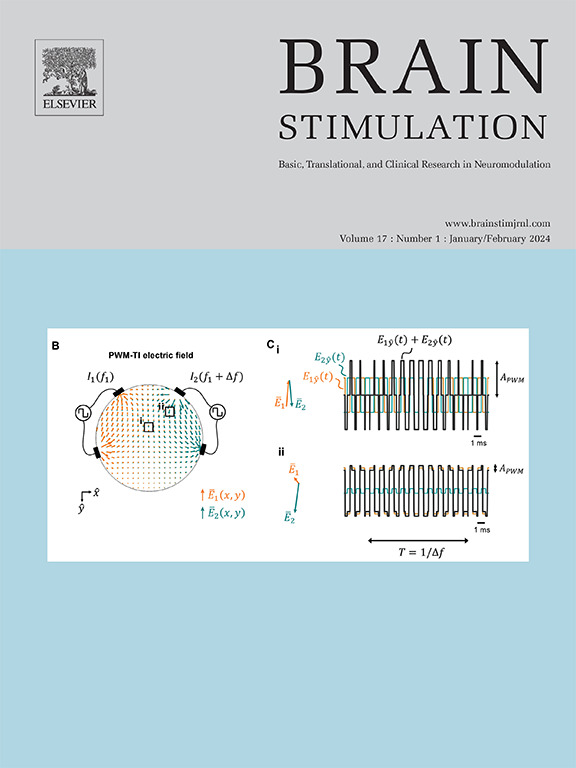Continuous theta-burst stimulation of the prefrontal cortex in the macaque monkey: no behavioral evidence for within-target inhibition or neural evidence for cross-hemisphere disinhibition
IF 8.4
1区 医学
Q1 CLINICAL NEUROLOGY
引用次数: 0
Abstract
Background
Continuous theta-burst stimulation (cTBS) can perturb neural activity and behaviour by inducing effects that persist beyond the relatively short stimulation period. Although widely used in basic research and clinical settings, there lacks an understanding of the neurophysiological and behavioral effects of cTBS.
Objectives/hypothesis
Two assumptions motivating the use of cTBS are that it will i) inhibit neural activity in the targeted area, and ii) consequently disinhibit neural activity in the mirroring region in the contralateral cortex. Here, we test these assumptions in the oculomotor system of healthy rhesus macaques.
Methods
In two macaques, we delivered cTBS between blocks of trials where they performed a delayed pro-/anti-saccade task. We delivered cTBS to the right PFC (areas 8Ar and 46, which includes the frontal eye fields; 32 cTBS-PFC sessions), to the air as a SHAM control (27 cTBS-SHAM sessions), or to the nearby primary motor cortex as a brain control (21 cTBS-M1 sessions). Across these different types of sessions, we compared changes in oculomotor behaviour (reaction times, error rates, peak saccade velocity), and changes in neural activity recorded from the left, contralateral PFC.
Results
Despite multiple lines of evidence consistent with TMS influencing neural activity in the cTBS-PFC and cTBS-M1 sessions, we found no behavioral evidence for inhibition of the right PFC in the cTBS-PFC sessions, nor any evidence for contralateral disinhibition in the left PFC.
Conclusions
Our results call into question some of the fundamental assumptions underlying the application of cTBS.
猕猴前额叶皮层的持续θ -burst刺激:没有目标内抑制的行为证据或跨半球去抑制的神经证据。
背景:连续脉冲刺激(cTBS)可以通过诱导在相对较短的刺激期后持续的效应来扰乱神经活动和行为。尽管cTBS在基础研究和临床环境中广泛使用,但人们对cTBS的神经生理和行为影响缺乏了解。目的/假设:促使cTBS使用的两个假设是:它将i)抑制目标区域的神经活动,ii)因此解除对侧皮质镜像区域的神经活动。在这里,我们在健康恒河猴的眼部运动系统中测试了这些假设。方法:在两只猕猴中,我们在它们执行延迟的促/反扫视任务时,在试验块之间传递cTBS,将cTBS传递到右侧PFC(区域8Ar和46,包括额叶视野;32个cTBS-PFC会话),到空中作为SHAM控制(27个cTBS-SHAM会话),或到附近的初级运动皮层作为大脑控制(21个cTBS-M1会话)。在这些不同类型的会话中,我们比较了动眼肌行为的变化(反应时间、错误率、峰值扫视速度),以及从左侧对侧pfa记录的神经活动的变化。尽管有多条证据表明经颅磁刺激会影响cTBS-PFC和cTBS- m1会话中的神经活动,但我们没有发现cTBS-PFC会话中右侧PFC抑制的行为证据,也没有发现左侧PFC对侧去抑制的证据。结论:我们的结果对cTBS应用的一些基本假设提出了质疑。
本文章由计算机程序翻译,如有差异,请以英文原文为准。
求助全文
约1分钟内获得全文
求助全文
来源期刊

Brain Stimulation
医学-临床神经学
CiteScore
13.10
自引率
9.10%
发文量
256
审稿时长
72 days
期刊介绍:
Brain Stimulation publishes on the entire field of brain stimulation, including noninvasive and invasive techniques and technologies that alter brain function through the use of electrical, magnetic, radiowave, or focally targeted pharmacologic stimulation.
Brain Stimulation aims to be the premier journal for publication of original research in the field of neuromodulation. The journal includes: a) Original articles; b) Short Communications; c) Invited and original reviews; d) Technology and methodological perspectives (reviews of new devices, description of new methods, etc.); and e) Letters to the Editor. Special issues of the journal will be considered based on scientific merit.
 求助内容:
求助内容: 应助结果提醒方式:
应助结果提醒方式:


